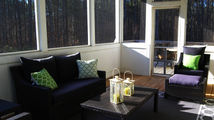Help for Spring Allergies
- Heather Marvin
- Feb 11, 2021
- 4 min read
Updated: Feb 2, 2022

For many spring equals seasonal allergies. Sadly, in addition to seasonal allergies, many suffer from an array of allergies all year long. The list of allergens can be long and usually includes pollen, pet dander, dust, and products used for cleaning, bathing and laundry.
There are two basic ways to reduce these allergies which will improve your quality of life.
Frequent & correct cleaning.
Choosing cleaning and personal care products carefully.
This article will show you exactly what you need to do.
Frequent Cleaning
When done properly, regular basic cleaning can reduce dust, pollen, pet dander, as well as mold in the home and work space. Carpet can be a major culprit of allergy irritation but it can also be your ally. Carpet traps dust, pollen, and pet hair preventing it from circulating back into the air. In order for this not to become a problem, the carpet should be vacuumed 2xs per week – using the right kind of vacuum - and steam cleaned at least two times a year. Throw rugs and floor mats should be washed weekly according to the MayoClinic.
What is the right kind of vacuum? Cyclonic vacuums with clean HEPA filtration is ideal. Other vacuums allow small particles of pollen and pet dander to circulate back into the air. The cyclonic HEPA vacuums traps allergens - completely removing them from the indoor environment.
Hardwood and/or tile floors have become very popular and most homes have this type of flooring throughout. It is important to remember that with these floors the dust, dander & pollen have no where to go once they land. Unless they are removed, they will circulate back into the air over and over again. Regular vacuuming and proper mopping is vital. It is best to use a cloth or mop that can actually grab these tiny particles instead of just push them around. A damp cloth or mop is effective. Microfiber cloths & mops are the best choice at getting the job done right. As the name implies, the micro fibers attach to these tiny particles like Velcro - removing them completely. Microfiber cloths are also the right tool for effective furniture dusting.
Other surfaces that can collect allergens are any soft textiles like curtains, upholstered furniture, sheets, pillowcases and blankets. The Asthma & Allergy Foundation of America (AAFA) recommends washing bedding once per week in hot (130 Degree) soapy water. Curtains should be washed periodically – every 3 to 6 months depending on your personal situation. (Pets, heavy traffic in and out of the space, and heavy dust will require a more frequent schedule.)
Frequently cleaning these allergen collecting hot spots will greatly help reduce allergies. The AAFA also stated that for those who suffer with allergies and asthma, regular cleaning should be done aggressively.
Air quality is super important in reducing allergies. How can you make sure the air is cleaned frequently? Make sure the air ducts and vents in your home are vacuumed and dust free. This will take the pressure off any air filtration system you have - such as heating and air conditioning. Speaking of that, be sure to have proper air filtration. For central air or forced heat, use a HEPA filter. If this is not an option, then a room air filter may be necessary - but choose carefully. Lastly, make sure there is ample air flow throughout the space.
Product Choice
Sometimes we feel like we are doing a good thing by using cleaning and personal care products that are reported to be the most effective on the market. Often though, these common household items such as shampoos, laundry detergents, and the vast array of cleaning products can cause more harm than good. In fact, the prolific use of these items has caused chemical allergic reactions for many people. And even those who do not notice the effects can be damaging their health by using them.
WebMD reports that many shampoos, cleaners and detergents contain the following allergens: fragrances, preservatives, anti-bacterials, thickeners, lubricants, dye chemicals, formaldehyde resins, and sunscreen chemicals. For more details on the chemical ingredients of common household products, please read the article House Cleaning - Why Use Eco Friendly Cleaners?
To compound the problem, aerosol sprays themselves trigger allergy symptoms and weekly use of cleaning sprays are linked to an increased rate of asthma episodes. The solution? Choose eco-friendly products. Even though these are not regulated for purity, they are less likely to contain harmful chemicals. Using products that have the "USDA Organic" seal or the "Green Seal" on the label is a better option. Many times though, you can use non toxic items that you already have in your home for cleaning, personal care use, and laundry detergents. One well known example of this is baking soda. A box of Arm & Hammer baking soda lists all of the ways it can be used. It is cheap and effective. Other items to look into using are vinegar, hydrogen peroxide, washing soda, borax, Bon Ami cleanser and good old fashioned hot water. Click here to learn how to use these.
Two ways to reduce allergies are correct frequent cleaning and good product choice. Some may argue that these methods are not so easy and they do require a bit more effort. Even though having a better quality of life requires a bit of work, the pay off is well worth it! And really, once these areas are addressed, over time the work load becomes easier. Frequent cleaning means less build up and quicker cleaning times. Better products will help improve your health, stamina, and ultimately happiness.
Schedule An Appointment
Resources - The Asthma & Allergy Foundation of America; WebMD
Clean LLC | Keep Naturally Clean
Eco Friendly Home Cleaning Service & More
Serving Fairfield & Litchfield Counties of Connecticut
Including Warren & West Cornwall




































